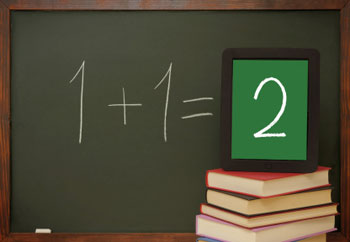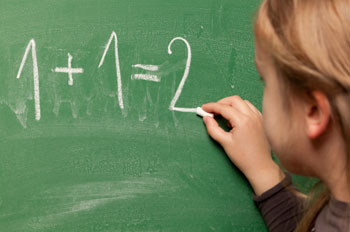Math Help for 4th Grade: Making a Table
In 4th grade you will learn to create and read various charts, graphs and tables. Tables are used to compare various amounts and identify the relationship between the numbers. Here are some tips for making and reading tables.

Help with Math Tables
Reading Tables
The key to understanding a chart or table is to read the labels, which are often found at the top of the table. Here, you will see the units of measurement. Usually, there is some kind of interaction between the headings on two sides of the chart or table.
For example, the left side might read 'price in dollars' and the right side might be labeled 'books.' These headings tell you that there is a relationship between the price of the book and the types of books.
Creating Your Own
Make your own inches-to-feet conversion chart on a piece of notebook paper. Draw two neat columns in a box, and write 'inches' and the top of one and 'feet' at the top of the other. In the 'feet' column, write the numbers 1-10. Then, in the 'inches' column, convert the feet to inches by multiplying by 12. For instance, the first column should read 12 inches, since that is the equivalent to one foot. You can now use this chart to quickly and easily convert feet to inches or inches to feet.
You can make tables for just about anything. For example, create a table to compare the amount of students in your class that prefer cake or pie. Set up your two columns, interview every student in your class and then record the numbers. The graph will allow you to easily compare the two amounts.
Additional Charts and Graphs
Graphs are used to visually represent information. Often, after creating a table, you will then make a graph to represent that information. Two kinds that you may work with this year are pie charts and bar graphs. A pie chart is a circle divided into sections, like pizza slices of different sizes. With bar graphs, you use vertical lines to represent the relationship between two amounts.
Using our cake and pie example from above, you could visually represent the information by making a bar graph. Begin by drawing vertical and horizontal lines that intersect. Label the vertical line 'number of students', and the horizontal line 'type of dessert'.
Now, let's say that 13 students preferred cake, and 11 preferred pie. Use a blue marker to represent the number of students who liked cake. Draw a vertical line all the way up to the number 13. Then, use a green marker to represent the amount that liked pie. Draw a vertical line all the way up to the number 11.
Other Articles You May Be Interested In
-
MIND Games Lead to Math Gains

Imagine a math teaching tool so effective that it need only be employed twice per week for less than an hour to result in huge proficiency gains. Impossible, you say? Not so...and MIND Research Institute has the virtual penguin to prove it.
-
Should Math Be a Main Focus in Kindergarten?

Should kindergartners put away the building blocks and open the math books? According to recent research, earlier is better when it comes to learning mathematical concepts. But that could put undue pressure on kids, parents and even teachers.
We Found 7 Tutors You Might Be Interested In
Huntington Learning

- What Huntington Learning offers:
- Online and in-center tutoring
- One on one tutoring
- Every Huntington tutor is certified and trained extensively on the most effective teaching methods
K12

- What K12 offers:
- Online tutoring
- Has a strong and effective partnership with public and private schools
- AdvancED-accredited corporation meeting the highest standards of educational management
Kaplan Kids

- What Kaplan Kids offers:
- Online tutoring
- Customized learning plans
- Real-Time Progress Reports track your child's progress
Kumon

- What Kumon offers:
- In-center tutoring
- Individualized programs for your child
- Helps your child develop the skills and study habits needed to improve their academic performance
Sylvan Learning

- What Sylvan Learning offers:
- Online and in-center tutoring
- Sylvan tutors are certified teachers who provide personalized instruction
- Regular assessment and progress reports
Tutor Doctor

- What Tutor Doctor offers:
- In-Home tutoring
- One on one attention by the tutor
- Develops personlized programs by working with your child's existing homework
TutorVista

- What TutorVista offers:
- Online tutoring
- Student works one-on-one with a professional tutor
- Using the virtual whiteboard workspace to share problems, solutions and explanations